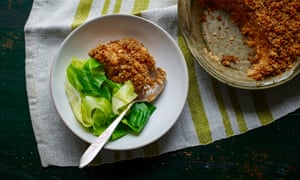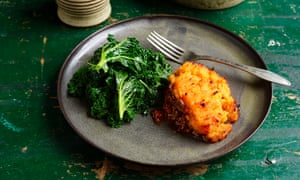
Swedes are never someone’s favourite vegetable. The new season is rarely heralded and yet they remain stout and sturdy workhorses of the English larder. We grow fields of them on Riverford farm, but have to be cautious about their frequency in our weekly veg boxes, as people still find them a little uninspiring or intimidating, and they can conjure a feeling of post-war austerity.
For all their seeming ubiquity they carry with them a wonderful variety of names and colloquialisms. Most of the world refer to them as rutabagas, but the Scottish neeps or tumshies still maintain common usage. My current favourite is the northern snadgers, if only because instructing someone to, “now mash your snadgers” has a mischievous whiff of Roald Dahl about it.
Swede is strictly an autumn-winter veg; the season begins in late Sept and ebbs in late Feb/early March. The supermarkets seem to feel the need to bridge the summer gap with imports but I, for one, can’t fathom why. The comforting sweet, earthy and slightly bitter taste gives itself to the afternoon gloaming and chill nights between October and February. I’d say that, for the most part, it’s pointless to deny swede’s magnetism to dairy in one form or another; it really does bring out the flavour. You can roast it in generous chunks, bake it in rich buttery gratins or use it to fortify stews and casseroles, but the guise in which we know it best is simply mashed as part of a roast dinner. Cheap, countrywide and abundantly in season – fill your basket, whip up a simple batch of mash and give a swede a home this autumn.
To make 2kg of mashed swedes
4-5 swedes, top and tailed, peeled and cut into 2cm cubes
2 bay leaves
Salt
1 Cover the swede with cold water. Add the bay leaves and some salt. Gently bring to the boil. Simmer for about 20‑30 minutes, or until tender.
2 Drain well, reserving the cooking water. Return the dice to the pan over a very low heat for a few minutes to evaporate any excess water, taking care that they don’t burn or stick.
3 Mash until coarse. Blending in a food processor is faster, less of a chore and will give you a smoother purée. It will never be silken, so lightly lumpen is all part of the charm. At this point, for a standard mashed swede you would beat in some butter, nutmeg and white pepper. Instead, try the following …
The big dipper: Spiced swede and onion beignets with lime pickle yoghurt (pictured above)
This recipe has been having a bit of an identity crisis. Is it a bhaji? The spicing and tangle of onions would suggest so. A fritter? The consistency and drop-scone quality could qualify it. I settled on beignet, as it is a crude kind of choux pastry that is formed from the boiling liquid, butter and eggs. No doubt there is an element of menu manipulation about the title, beignet does have a fancy feel to it. For a more homely version of these beignets you can lose the spices in favour of a little chopped rosemary and finely chopped crispy bacon, and dip in aioli or salad cream instead. These beignets would also work with potato, celeriac, parsnip and even beetroot in place of the swede.
Serves 4
1 large onion, peeled and finely sliced
100ml swede cooking water/plain water
25g butter
½ tsp turmeric
1½ tsp garam masala
¼ tsp cayenne pepper
50g plain flour, sifted
2 eggs
1 egg yolk
300g mashed swede
A handful of fresh coriander, chopped
Oil, for frying
1 tbsp lime pickle, chopped into a paste
3 tbsp plain yoghurt
1 Gently fry the onion for 20-30 minutes until it has collapsed and become very soft. Allow it to take on a little golden colour but be careful not to let it burn. Add a dash of water every so often if it looks like doing so.
2 Meanwhile, heat the cooking water with the butter, spices and a generous seasoning of salt and pepper until just simmering. Add the flour, then mix vigorously with a wooden spoon until smooth, completely combined and pulling away cleanly from the side of the pan. Set aside for 5 minutes. Beat in the eggs and yolk, one at a time with a stiff whisk or in a food mixer, making sure one is very well combined before adding the next, until you have a glossy paste.
3 Drain the slow cooked onions of any liquid and oil. Fold into the choux pastry along with the mashed swede. Cover the mix with cling film and refrigerate, for a few hours ideally.
4 Meanwhile, add the pickle to the yoghurt, plus some oil from the jar.
5 Add enough oil to reach a depth of 50mm in a high-sided pan. Heat the oil to 180C/350F, or until a cube of bread browns in less than a minute.
6 Mix the coriander and into the chilled dough. Shape a spoonful of mix between two spoons until it looks like an egg. The mix will be quite wet so the shaping will be a little imperfect. Scrape the shaped mix carefully into the oil, then repeat.
7 Fry in batches of up to 5 at a time, for 3-4 minutes until golden and crisp, turning halfway through. Drain on kitchen paper, then keep warm in a low oven while you cook the next batch.
8 Serve warm, with the yoghurt dip.
The weeknight warmer: Lentils, swede puree and aillade
This swede puréee is laced with a cautious but pronounced hit of star anise (trust me, it works) but too much and the balance is lost and you’ll taste nothing but liquorice. Aillade is a pungent mix of garlic, parsley and walnuts, just think of it as a winter pesto as it should have the same consistency.

Serves 4
1 red onion, finely diced
1 carrot, finely diced
1 celery stick, finely diced
200g dark speckled/puy lentils
1 bay leaf
2 whole cloves
1 small sprig of thyme
400ml vegetable or chicken stock
1 garlic clove, peeled
Walnuts, lightly toasted
A handful of parsley, roughly chopped
Olive oil
25g butter
300g swede, pureed
1 point from a star anise, finely ground
1 tbsp creme fraiche
1 tbsp red wine vinegar
Salt and white pepper
1 Gently fry the onion, carrot and celery for 10 minutes, until starting to soften.
2 Stir in the lentils, bay, cloves and thyme. Fry for a few minutes, add the stock and gently simmer for 30–45 minutes until the lentils have absorbed most of the liquid and are just tender but not turning to mush.
3 Meanwhile, crush the garlic to a paste along with the walnuts, parsley and a pinch of salt. Add enough oil to make a spoonable pesto. Season.
4 Melt the butter in a small pan. Add the swede and ground anise. Keep turning and beating the swede with a wooden spoon or spatula until it is warmed through. Remove from the heat. Beat in the creme fraiche. Season with a little salt and white pepper to taste.
5 When the lentils are ready, fish out the bay, cloves and thyme. Stir through the vinegar. Season. Ladle the lentils into serving bowls. Dollop an island of swede puree in the middle and top with aillade.
The Scandi staple: Lanttulaatikko
This Finnish casserole is a festive staple and a keystone of any Yuletide spread. I first came across it as one of those culinary curios, but it isn’t too far removed from the tap-root of our own Christmas canon. The odd merging of savoury and sweet used here is from a time before certain flavours and spices were marshalled into one camp or the other. Always on the lookout for new ways with veg, we served this a few times last December to a wary but ultimately converted public. If you can’t get molasses then some dark muscovado sugar, honey or even maple syrup will do. Some versions suggest using the breadcrumbs solely as a gratin-like topping; I feel that some need to be stirred through the mix to add body. Delicious served with salty baked ham and dark, wilted, bitter greens or, dare I say it, sprouts.

Serves 4
1 egg
150g double cream
½ tsp freshly ground nutmeg
½ tsp ground ginger
1 tbsp molasses/black treacle
60g stale white breadcrumbs
800g mashed swede
50g butter
Salt
1 Set the oven to 160C/325F/gas mark 3. Whisk the egg into the double cream with the nutmeg, ginger, molasses and half the breadcrumbs. Beat the cream mix into the swede, season with salt and tip the mix into an oven dish (about 20 x 25cm).
2 Melt the butter in a small pan. Stir in the remaining breadcrumbs. Scatter over the swede. Bake for 50-60 minutes, until golden.
The reinvented classic: Shepherd’s pie with stout
Swede works wonders with dark, rich meat. Beef, mutton and game will all allow the humble swede to assume the potato’s place, on occasion. If you can get mutton I would recommend it, I know it is oh-so-trendy at the moment but I can, hand on heart, say the best sheep I’ve ever tasted was 4-year-old mutton, from Langley Chase farm in Wiltshire.
The optional addition of heart is a sideways nod, along with the allspice, to swede’s affinity with the haggis, without being too overtly offal-y. I’ve chosen to add a little mashed carrot with the swede here just to give it a little more structure and bulk. Think of the stout as your stock; it will need a flash of acidity in the guise of the vinegar to lift the heaviness and cut the fattiness of the meat. Serve with simply wilted savoy cabbage or black kale, and a round of the relevant stout.

Serves 4
1 large onion, finely diced
1 carrot, finely diced
1 celery stick, finely diced
600g coarsely minced mutton or lamb
1 lamb’s heart, trimmed and finely chopped (optional)
3 garlic cloves, finely chopped
2 small salted anchovy fillets
1 tbsp tomato puree
1 tbsp red wine vinegar
Sprig of thyme, leaves stripped and chopped
Sprig of rosemary, leaves stripped and chopped
2 bay leaves
300ml dark stout
½ tsp ground allspice
Reserved swede cooking water
400g carrots, or floury potatoes if you prefer, peeled and chopped
100g butter
600g mashed swede
Nutmeg, for seasoning
Salt and white pepper
1 In a large casserole, fry the diced onion, carrot and celery in a little oil for 10 minutes, until starting to soften. Set the oven to 160C/325F/gas mark 3. Meanwhile, in a large pan, fry the mutton (and heart, if using) over a high heat until nicely browned. This is best done separately as it is hard to get a good colour on the meat when it is competing for heat and space with the onions.
2 Add the meat to the onions, plus the garlic, anchovy fillets, tomato puree and vinegar. Cook for 5 minutes, until the anchovy disintegrates and the vinegar has mostly evaporated.
3 Add the thyme, rosemary, bay leaves, to the pan along with the stout and allspice, plus just enough of the swede’s cooking water to cover the meat. Season everything well with salt and white pepper, cover with a tight fitting lid, or foil, and cook in the oven for 1 ½ hours.
4 In a pan of cold, salted water, bring the carrots to the boil, then simmer for 30 minutes until soft. Drain well and mash. Beat in the butter until melted and well combined. Fold in the mashed swede and season well with salt, white pepper and a grating of nutmeg to your taste.
5 Take the meat out of the oven, it should be tender and thickened. Check the seasoning and adjust with salt and white pepper if needed. Evenly spread the swede mixture on top of the meat. Rake the surface with a fork. Turn the oven up to 200C/400F/gas mark 6. Bake for 25 mins, until the topping is coloured.
[Source:- The Gurdian]
